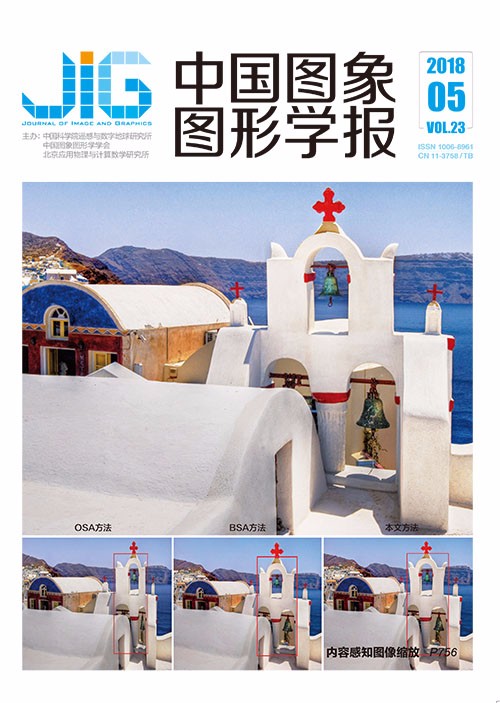
青铜器纹饰特征增强及自动提取
摘 要
目的 青铜器是我国的文化瑰宝,然而出土青铜器大多破损、变形,需要修复以进行保护。随着3维激光扫描技术及数字几何处理研究的发展,文物数字化修复技术得到了广泛的重视。在青铜器修复过程中需要将相邻碎片的纹饰对准,以保证纹饰的连续性,从而保证修复质量。因此,青铜器纹饰特征的有效提取是青铜器修复过程中的一项重要工作,鉴于青铜器纹饰特征一般具有比较明显的尖锐边,本文提出并实现了一种青铜器尖锐特征增强及自动提取算法。方法 首先,为了减少网格均匀度对特征提取的不利影响,提出一种加权法向距离;其次,为了增强尖锐特征提取效果,提出一种逆双边滤波算法,并利用该算法获得反锐化掩膜,增强法向距离间的差异性,使得大的更大,小的更小;最后,采用Otsu算法自动确定分割阈值,依据该阈值把网格顶点分为特征点集和非特征点集,实现青铜器纹饰特征的提取。结果 对实际3维激光扫描获得的青铜器模型,分别采用本文算法和Tran等人提出的尖锐特征自动提取算法进行了纹饰特征提取,包括采用两种算法进行了纹饰特征增强前后纹饰特征提取实验,本文使用的3个模型点数在6 000至80万之间,这些模型都可以在1 s到10 s之间得到最终的提取结果,具有较高的效率。同时,本文算法可以更为准确地提取尖锐特征点,且得到的特征点更为连续,有利于进一步的处理。结论 采用本文提出的青铜器纹饰提取算法,能够自动、高效地提取青铜器纹饰特征。
关键词
Enhancement and automatic extraction of bronze pattern features
Wang Yu, Chen Haimei, Li Weishi(School of Instrument Science and Opto-electronics Engineering, Hefei University of Technology, Hefei 230009, China) Abstract
Objective Bronzes are one of China's cultural treasures. However, most unearthed bronzes are broken and deformed, and restoration is needed to protect them. Recently, digital restoration technologies for cultural relics have attracted considerable attention with the development of 3D laser scanning technologies and the research progress in digital geometry processing. Patterns of the adjacent pieces of a broken bronze should be aligned during restoration to ensure the continuity of the patterns and guarantee high restoration quality. Consequently, the extraction of bronze patterns is a significant step in the restoration process. Method Generally, bronze patterns have apparent sharp edges, which distinguish decoration feature parts from non-decoration feature parts. Therefore, an algorithm for enhancing and extracting the sharp features of bronzes, which aims to extract pattern features, is proposed and implemented in this study. No interactive parameter setting is needed in the proposed algorithm, and the feature points are extracted automatically. First, a weighted projection distance is proposed to eliminate the adverse effect of the nonuniformity of the mesh on feature extraction. The projection distance of a vertex is the absolute value of the dot product between the normal at the vertex and the vector from the vertex to the center point of its one-ring neighborhood vertices. The projection distance of a vertex on sharp edges is always larger than that on non-sharp edges for a uniform triangular mesh model. Thus, it is easy to distinguish the feature point in this case. However, it is difficult to distinguish the feature point for the nonuniform mesh, which is more general in application. Therefore, the weighted projection distance, which means that all edges in the one-ring neighborhood of a vertex should be normalized first before calculating the projection distance, is more adaptive than the traditional projection distance for the triangular meshes in general. Then, reverse bilateral filtering is proposed and utilized to generate an anti-sharpening mask to enhance the weighted projection distance because the feature points are not obvious in the reconstructed mesh model of a real bronze as a result of the digital nature of the scanning process. The anti-sharpening mask is a three-step image enhancement process. First, the original image is filtered and subtracted from the smoothed image to obtain the weight. Second, the mask is added to the original image. Finally, the details of the image are enhanced. Reverse bilateral filtering is developed to filter all weighted projection distances with the intention to smooth all weighted projection distances of the feature points to the maximum extent instead of preserving features in bilateral filtering. The enhanced weighted projection distance is obtained by performing the three-step anti-sharpening mask in image enhancement. Consequently, a large weighted projection distance becomes even larger and a small weighted projection distance becomes even smaller. Finally, Otsu's method is applied to the histogram of the enhanced weighted projection distance to determine the optimal threshold automatically, and the vertices of the mesh model are classified into feature and non-feature point sets with the threshold. Result We compare the extraction results of our algorithm with those of Tran's algorithm with the scanned bronze models, including before and after weighted projection distance enhancement. All experiments show that better extraction results can be achieved with the proposed algorithm than the existing algorithms, and the identified feature points of the proposed algorithm are more continuous than those of the existing algorithms. The time consumed by all of the three models with vertex numbers between 6 000 and 800 000 is less than 10 s. Therefore, the proposed algorithm is effective, and its results are beneficial for the succeeding process. Conclusion The decoration features of bronzes can be extracted automatically and efficiently with the proposed algorithm.
Keywords
|



 中国图象图形学报 │ 京ICP备05080539号-4 │ 本系统由
中国图象图形学报 │ 京ICP备05080539号-4 │ 本系统由